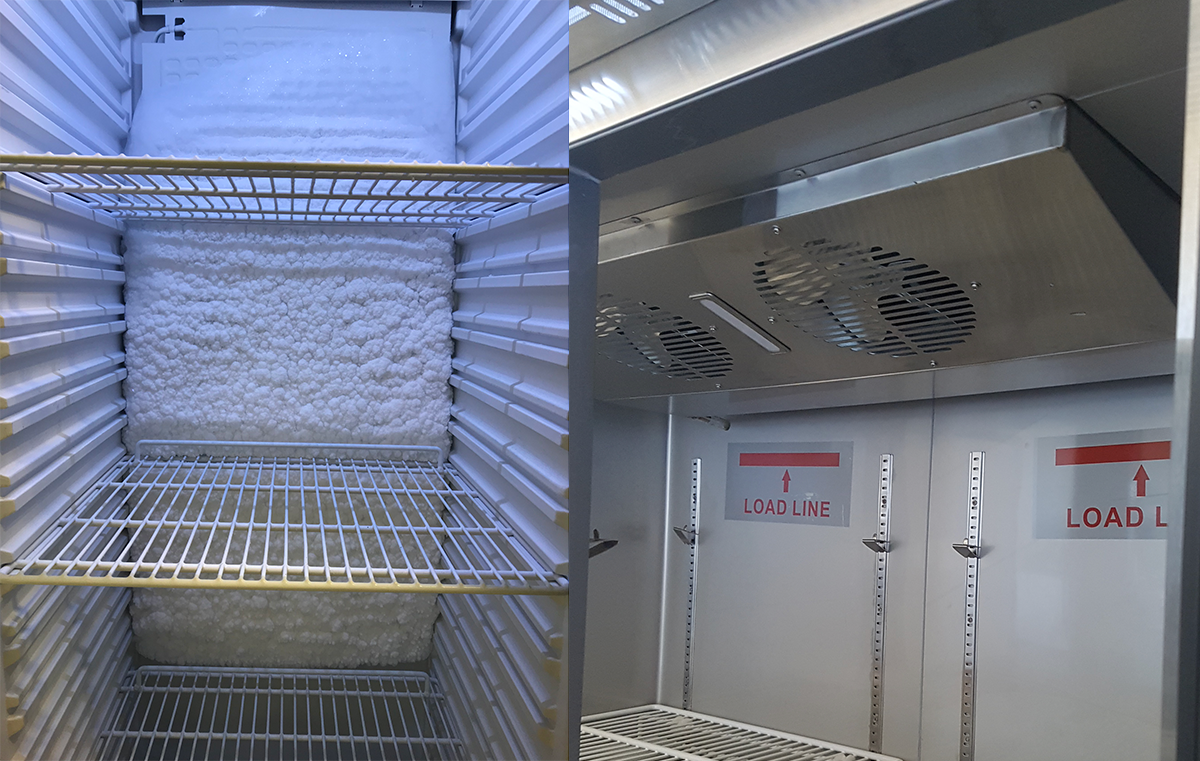All fridges and freezers have similar components in their cooling systems such as compressors, condensers and expansion valves. The process of removing heat remains fairly similar within the cooling system however how the heat is actually removed from the cabinet area of the fridge or freezer is different for various applications.
For instance, a chest freezer which is designed for storage and low power consumption which will not be opened many times each day doesn’t require a heavy-duty fan to rapidly cool its contents.
Conversely, a kitchen fridge which gets opened and closed continuously throughout the day and which is working in a hot kitchen environment requires those heavy duty fans to rapidly cool food once it is placed in the cabinet.
Let’s explore the three main types of cooling systems:
Static cooling is relatively simple and is adequate for storage but it is not ideal for high usage environments. The design of the these type of units is to freeze either the back internal wall or shelves (depending on design) to regulate the temperature. There is no fan inside the cabinet which means the air inside is static (non moving)
This is the cooling type used in chest freezers and cheap upright fridges and freezers. This is also the most likely cooling type for domestic refrigerators.
Pros:
- Cheaper to purchase than fan-forced fridges
- Cheaper to run
- Require less total footprint in the kitchen
Cons:
- Low ambient temperature rating
- Takes a long time to cool food
- Ice builds up over the cooling system and inside the cabinet
- Require manual defrosting by turning the fridge/freezer off overnight. This needs to be done every 4-6 weeks as required
- Limited access to cooling system
Ideal Usage:
- Chest freezers and upright storage fridges and freezers
- Not opened more than 6 times per 24 hours
- Back of house
Fan Assisted Static Cooling refers to static fridges with small internal fans which help to circulate the air inside. These are typically used in drink cheap fridges like domestic bar fridges and the Polar DM and GJ ranges (Upright bar fridges)
Fan Assisted Static Cooled fridges are ideal as drink fridges because liquids are much denser than food. This means that their internal temperature is not affected by temperature changes as quickly and do not require constant forced air to regulate their temperature.
Pros:
- Cheaper to purchase than fan-forced fridges
- Cheaper to run
- Require less total footprint in the kitchen
Cons:
- Low ambient temperature rating
- Takes a long time to cool internal
- Ice builds up over the cooling system and inside the cabinet
- Require manual defrosting by turning the fridge/freezer off overnight. This needs to be done every 4-6 weeks as required
- Limited access to cooling system
Ideal Usage:
- Drinks fridges and bar coolers
- Some storage fridges and freezers
- Not opened more than 6 times per 24 hours
Fan Forced fridges/freezers are more expensive than their static cooled counterparts because their cooling systems are slightly more complicated but much more effective and work in higher ambient temperatures. Where static fridges by definition don’t move the internal air very much, fan forced fridges work by forcing cooled air over food and drinks in the cabinet with large internal fans.
This is a much more efficient cooling mechanism as well as being much more effective at removing heat quickly. The added benefit is that because no walls or shelves freeze, there is no internal ice build up. Automatic defrosting is also standard with fan forced fridges and freezers, all factors mean that these units are better suited to high traffic parts of the restaurant like the kitchen and front of house where they get opened more than 6-10 times per day.
Pros:
- Most efficient and effective cooling cabinets
- Run in up to 38° - 43°C ambient temperatures
- Automatic defrosting
- Fast to chill/freeze items
- Easier access to cooling systems
Cons:
- Slightly more expensive than static fridges/freezers
- Some space utilized by the cooling system
- Not available in very compact footprints due to large cooling system
Ideal Usage:
- High end drinks fridges and bar coolers
- Storage fridges and freezers
- Display merchandising
- Back or front of house
Conclusion:
Unless you are after a long term storage freezer such as a chest freezer, we strongly recommend a fan forced fridge or freezer for every other situation. This is especially the case in a country like Australia which generally sees quite high temperatures, especially in busy kitchens.
Fan-forced refrigeration also works out cheaper in the long run when taking into account the long hot summers and the downtime they cause with cheaper static fridges which simply can’t handle the heat.
So why are static fridges and freezers still available to buy?
Even though they are not as effective as their fan-forced counterparts, their price point still makes them attractive to customers. Also, in the right environment, there is nothing wrong with static cooling. The challenges arise when cheap fridges/freezers are purchased without necessary research and understanding of the best use case. Also with the intention of doing the job of a fan-forced equivalent, which they are just unable to match.






